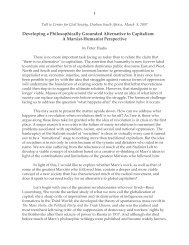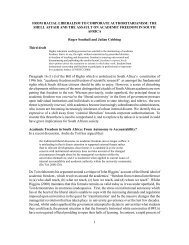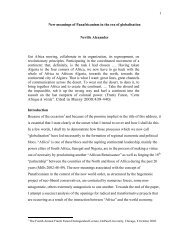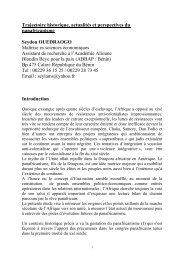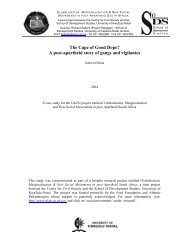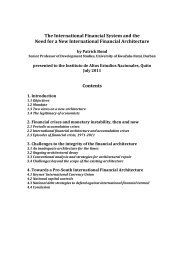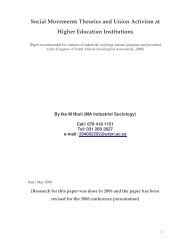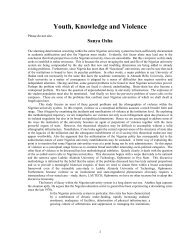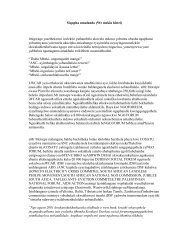April 2011 - Centre for Civil Society - University of KwaZulu-Natal
April 2011 - Centre for Civil Society - University of KwaZulu-Natal
April 2011 - Centre for Civil Society - University of KwaZulu-Natal
You also want an ePaper? Increase the reach of your titles
YUMPU automatically turns print PDFs into web optimized ePapers that Google loves.
Pambazuka News.<br />
South Africa prepares <strong>for</strong> ‘Conference <strong>of</strong> Polluters’<br />
Patrick Bond 27 January <strong>2011</strong><br />
At the past two United Nations Kyoto Protocol’s ‘Conference <strong>of</strong> the<br />
Parties’ (COPs) climate summits, Copenhagen in 2009 and Cancún in 2010,<br />
as well as at prior meetings such as Nairobi, how did South African<br />
leaders and negotiators per<strong>for</strong>m?<br />
Sadly, they regularly let down their constituents, their African<br />
colleagues as well as the global environment.<br />
Most embarrassingly, going <strong>for</strong>ward to the Durban COP 17 in November,<br />
the<br />
new Green Paper on climate under public debate this month promotes two<br />
dangerous strategies – nuclear energy and carbon trading – and concedes<br />
dramatic increases in CO2 emissions.<br />
South Africa is building two massive coal-fired plants at Kusile and<br />
Medupi (the world’s third and fourth largest), opening an anticipated<br />
<strong>for</strong>ty new coal mines in spite <strong>of</strong> scandalous local air and water<br />
pollution, and claiming that more ‘carbon space’ to pollute the air and<br />
thus threaten future generations is required <strong>for</strong> ‘development’.<br />
SA was not required to cut emissions in the first (1997-2012) stage <strong>of</strong><br />
the Kyoto Protocol. But when it comes to a potential second stage, which<br />
ideally would be negotiated in Durban, South Africa’s negotiators are<br />
joining a contradictory movement <strong>of</strong> emerging economic powers which<br />
both<br />
want to retain Kyoto’s North-South differentiation <strong>of</strong> responsibility to<br />
cut emissions, and to either gut Kyoto’s binding targets or establish<br />
complicated, fraud-ridden <strong>of</strong>fsets and carbon trades which would have the<br />
same effect.<br />
The 2006 Nairobi COP helped set the tone, because Pretoria’s minister <strong>of</strong><br />
environment and tourism at the time was Marthinus van Schalkwyk,<br />
<strong>for</strong>merly head <strong>of</strong> the New National Party. (He is today merely tourism<br />
minister.)<br />
A new Adaptation Fund was established in Nairobi, but its resources were<br />
reliant upon revenues from the controversial Clean Development<br />
Mechanism<br />
(CDM) carbon trading mechanism. Last week the European Union<br />
announced a<br />
ban on the main source <strong>of</strong> CDM credits, Chinese refrigeration gas<br />
emissions that are responsible <strong>for</strong> nearly two thirds <strong>of</strong> recent payments,<br />
because they incentivized production <strong>of</strong> more greenhouse gases.<br />
The CDM market is worth less than $8 billion/year at present, and Africa<br />
has received only around 2 percent, mostly <strong>for</strong> South African projects<br />
like the controversial Bisasar Road dump in Durban’s Clare Estate<br />
neighbourhood. Community activists led by the late Sajida Khan had<br />
demanded that Bisasar be shut but in 2002 the World Bank promised R100<br />
million in funding to convert methane from rotting rubbish into<br />
electricity, hence downplaying local health threats and environmental



